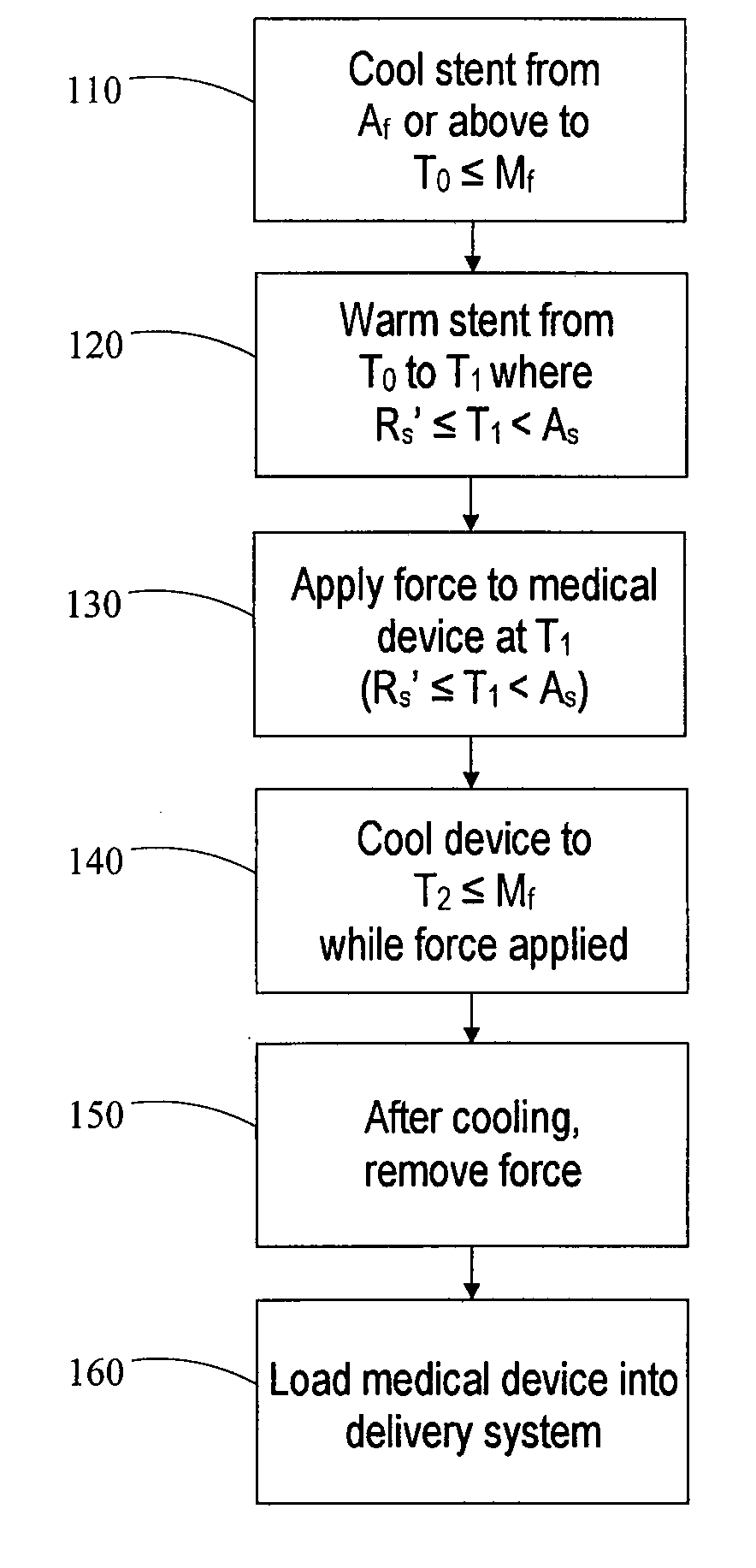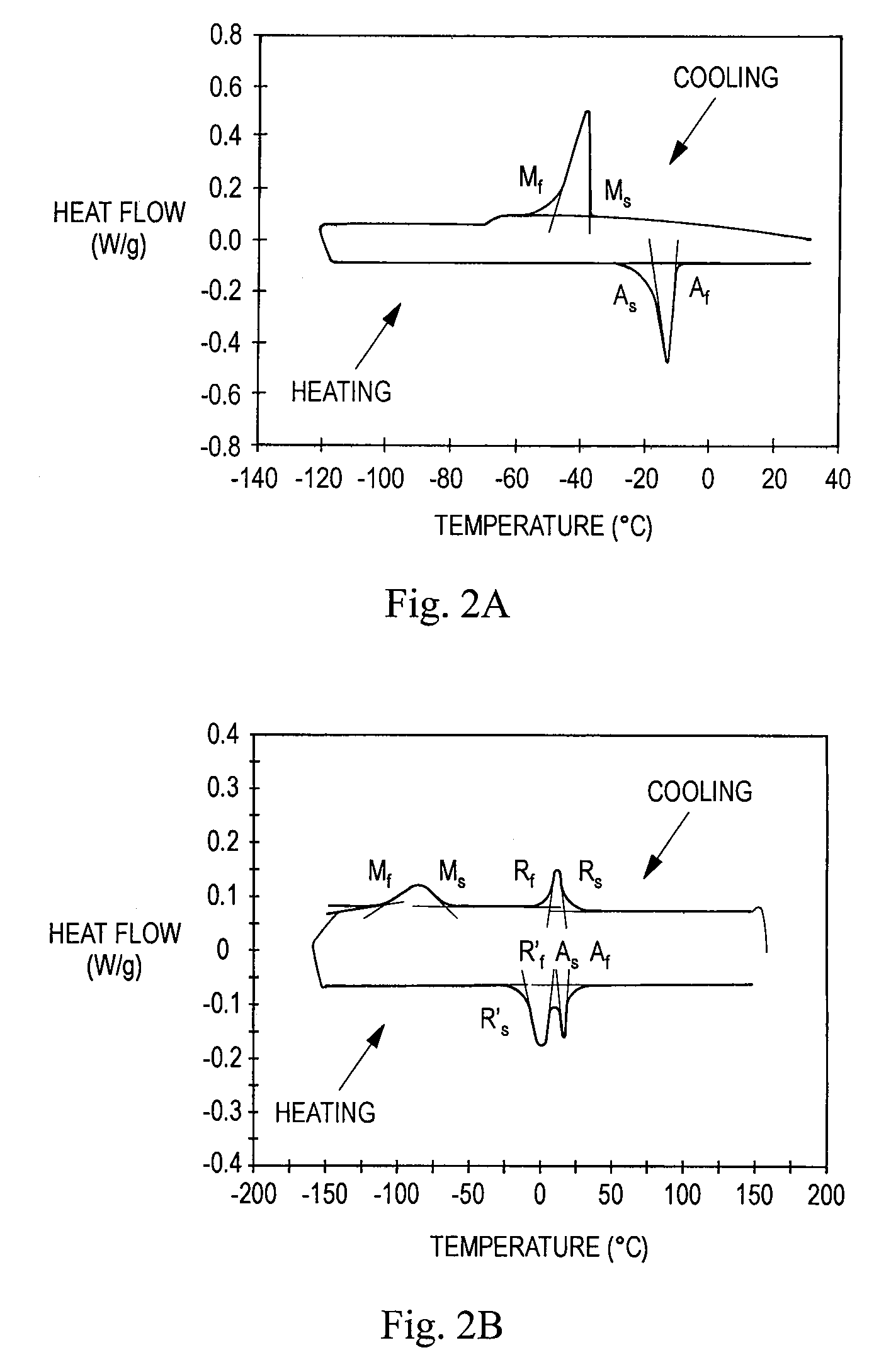Method for loading a medical device into a delivery system
- Summary
- Abstract
- Description
- Claims
- Application Information
AI Technical Summary
Benefits of technology
Problems solved by technology
Method used
Image
Examples
example 1
[0097]A self-expanding stent comprising a nickel-titanium shape memory alloy having transformation temperatures within the ranges given in Table 1 is loaded into a transfer tube. The steps of the exemplary loading process described in this example are shown schematically in FIG. 3B.
[0098]First, the stent is heated 100 to a temperature at or above the austenite finish temperature Af of the shape memory alloy. After equilibrating in an environment maintained at a temperature of about 40° C., which is above Af, the stent is transported to an enclosed environment (“cold box”) maintained at a temperature of about 10° C. The stent is then immersed in liquid nitrogen having a temperature of about −196° C. for several seconds to cool 110 the stent and induce a phase transformation to martensite. The immersion is carried out in a liquid-nitrogen filled container having dimensions large enough to completely submerge the stent. Additional liquid nitrogen may flow into the container periodicall...
example 2
[0103]Self-expanding stents comprising a nickel-titanium shape memory alloy having the transformation temperatures given in Table 2 are loaded into transfer tubes in a series of tests (Experiments 1.1 to 3.2) described below. The results of the tests are summarized in Table 3.
TABLE 2TransformationApproximate Value forTemperatureStents of Example 2 (° C.)Af29As20Rs26.5R′f~20-30Rf15R′s2.5Ms−34Mf−85
[0104]In the experiments, each stent is heated or cooled to a temperature within a specified R-phase temperature range, and then compressed as described in Example 1 at that temperature. The structure of each stent is thus partially or fully R-phase prior to compression. The impact of the training step (cooling prior to release of the compressive force) on the loading process is explored in the experiments.
experiment 1.1
[0105]Stent Warmed to R′s>T>R′f for Compression
[0106]For this experiment, the loading procedure is carried out as follows. First, the stent is immersed in liquid nitrogen until the stent attains a temperature of about −196° C. Next, the stent is allowed to warm up to a temperature of greater than R′s of the shape memory alloy but less than R′f. Within this temperature regime, it is expected that stent includes both martensite and R-phase. The stent is then compressed using approximately 10 lbs of force. During the compression, the stent is dipped in liquid nitrogen for about 40 seconds. The stent is removed from the liquid nitrogen and the force is released. Finally, the stent is loaded into a tube having an internal diameter of 1.65 mm. The experiment is carried out using two different stents, each measuring 7 mm (expanded diameter)×140 mm (length).
[0107]During the loading procedure using the first stent (#151123-2), the cold box is maintained at a temperature of about 7.3° C. A th...
PUM
| Property | Measurement | Unit |
|---|---|---|
| Time | aaaaa | aaaaa |
| Force | aaaaa | aaaaa |
| Temperature | aaaaa | aaaaa |
Abstract
Description
Claims
Application Information
 Login to View More
Login to View More - R&D
- Intellectual Property
- Life Sciences
- Materials
- Tech Scout
- Unparalleled Data Quality
- Higher Quality Content
- 60% Fewer Hallucinations
Browse by: Latest US Patents, China's latest patents, Technical Efficacy Thesaurus, Application Domain, Technology Topic, Popular Technical Reports.
© 2025 PatSnap. All rights reserved.Legal|Privacy policy|Modern Slavery Act Transparency Statement|Sitemap|About US| Contact US: help@patsnap.com



